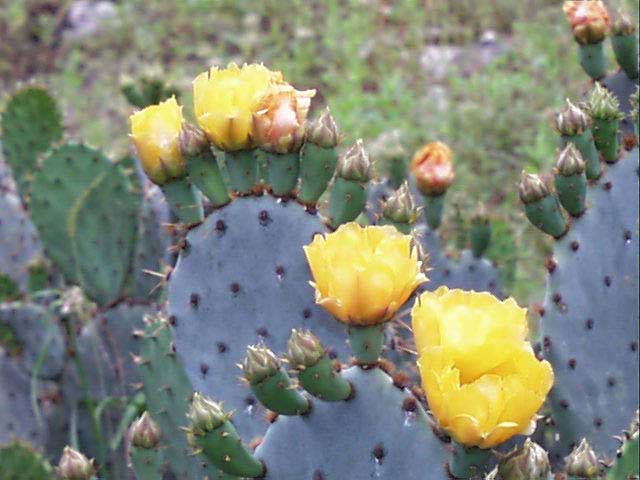
This spiny, evergreen cactus has distinct flat, broad pads that are blue-green in color, stemming from a trunk. It can grow quite tall and wide, and in Spring, it may produce yellow flowers that bear purple fruit.
Table of Contents
Care and Propagation Information

Planting Opuntia engelmannii var lindheimeri “Texas Pricklypear” in your outdoor succulent garden is an excellent choice. It is resistant to deer, and its flowers offer a source of nectar for bees and hummingbirds.
Watering
The ideal way to care for Opuntia engelmannii var lindheimeri “Texas Pricklypear” is to use the “soak and dry” method, allowing the soil to dry out completely in between waterings. This watering pattern is typical for succulents.
Where to Plant
If you live in an area where temperatures drop below 10° F (-12° C) during the winter, it is best to grow the Texas Pricklypear in a pot that can be brought indoors. This succulent does best with full to partial sunlight.
Put your plant in a spot where it will get at least 6 hours of sunlight every day. If you’re keeping it indoors for the winter, make sure you position it close to a south-facing window to get the most sunshine. You may need to use a grow light to provide additional light if needed.
How to Propagate Opuntia engelmannii var lindheimeri “Texas Pricklypear”
It is possible to grow Texas Pricklypear (Opuntia engelmannii var lindheimeri) from stem cuttings or seeds.
Cuttings
To propagate “Texas Pricklypear” by cuttings, use a clean, sharp knife or scissors. Take a stem from the existing plant and let it form a protective layer over the cut end for several days. Plant the cutting in well-draining soil and water only when the soil has been completely dried out.
This post provides information on how to grow cactus pads.
Seeds
To harvest seeds from a mature “Texas Pricklypear” plant, let the fruit ripen beyond its normal point, take the seeds out, and clean them. Once the seeds are dry, they can be planted in soil that is well-suited for drainage.
Gain an understanding of how to grow plants from seed by reading this article.
Care and Propagation Information
General Care for Opuntia engelmannii var lindheimeri “Texas Pricklypear”

Watering
The ideal way to care for Opuntia engelmannii var lindheimeri “Texas Pricklypear” is to use the “soak and dry” method, allowing the soil to dry out completely in between waterings. This watering pattern is typical for succulents.
Where to Plant
If you live in an area where temperatures drop below 10° F (-12° C) during the winter, it is best to grow the Texas Pricklypear in a pot that can be brought indoors. This succulent does best with full to partial sunlight.
Put your plant in a spot where it will get at least 6 hours of sunlight every day. If you’re keeping it indoors for the winter, make sure you position it close to a south-facing window to get the most sunshine. You may need to use a grow light to provide additional light if needed.
How to Propagate Opuntia engelmannii var lindheimeri “Texas Pricklypear”
It is possible to grow Texas Pricklypear (Opuntia engelmannii var lindheimeri) from stem cuttings or seeds.
Cuttings
To propagate “Texas Pricklypear” by cuttings, use a clean, sharp knife or scissors. Take a stem from the existing plant and let it form a protective layer over the cut end for several days. Plant the cutting in well-draining soil and water only when the soil has been completely dried out.
This post provides information on how to grow cactus pads.
Seeds
To harvest seeds from a mature “Texas Pricklypear” plant, let the fruit ripen beyond its normal point, take the seeds out, and clean them. Once the seeds are dry, they can be planted in soil that is well-suited for drainage.
Gain an understanding of how to grow plants from seed by reading this article.
